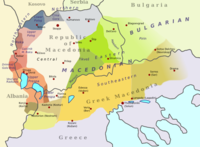Ser-Drama-Lagadin-Nevrokop dialect

The Ser-Drama-Lagadin-Nevrokop dialect is a dialect currently treated both in the contexts of the southeastern group of

The Serres-Nevrokop dialect is treated both in the contexts of Bulgarian and Macedonian dialectology.[10][11][12][13] As described in the section about its range, the vast majority of its speakers identify as Bulgarians. In the context of Bulgarian dialectology, the dialect is situated East of the Yat boundary and thus is considered to belong to the Eastern Bulgarian dialects, more exactly to the Rup subgroup[14][15]
The previous range of the dialect included vast areas of northeastern
Relationship to standard Bulgarian and standard Macedonian
The Serres-Nevrokop dialect possesses features (cf. table) which are typical for the Eastern
Comparison of the Serres-Nevrokop dialect with Standard Bulgarian and Standard Macedonian
| ||||||||||||||||||||||||||||||||||||||||||||||||||||||||||||||||||||||||||||||||||||||||||||||||||
|---|---|---|---|---|---|---|---|---|---|---|---|---|---|---|---|---|---|---|---|---|---|---|---|---|---|---|---|---|---|---|---|---|---|---|---|---|---|---|---|---|---|---|---|---|---|---|---|---|---|---|---|---|---|---|---|---|---|---|---|---|---|---|---|---|---|---|---|---|---|---|---|---|---|---|---|---|---|---|---|---|---|---|---|---|---|---|---|---|---|---|---|---|---|---|---|---|---|---|
|
Past and present range, emigration and expulsion to Bulgaria
Before the
The region suffered heavy devastation during the
Thus, refugees from Greek Macedonia comprised at least 110,000 to 140,000 of the 250,000
According to Hugh Poulton, the patterns of migration to Bulgaria differed across the different parts of Greek Macedonia. The majority of the Slavs roughly East of the
The Bulgarian authorities counted only 37,000 Bulgarians
Considering the above, as well as the strong Greek assimilation pressure, evident also before the Balkan Wars, it is generally unlikely for the Serres-Nevrokop dialect to be preserved in any significant numbers in its former territory in Greece.[
References
- ISBN 0-521-22315-6.
- ^ Mazon, Andre. Contes Slaves de la Macédoine Sud-Occidentale: Etude linguistique; textes et traduction; Notes de Folklore, Paris 1923, p. 4.
- ^ Селищев, Афанасий. Избранные труды, Москва 1968.
- ^ K. Sandfeld, Balkanfilologien (Copenhagen, 1926, MCMXXVI).
- ^ Белешки за говорот на селото Балевец (Лагадинско). Зборник на трудови посветени на академик Блаже Конески. Скопје: МАНУ, 1995, стр. 9–27.
- ^ Стойков, Стойко (2006). Българска диалектология. Акад. изд. "Проф. Марин Дринов".
- ^ a b Стойков, Стойко. Българска диалектология, София 2002, с. 170–186
- ^ a b str. 249- 252 Makedonski jazik za srednoto obrazovanie- S. Bojkovska, D. Pandev, L. Minova-Ǵurkova, Ž. Cvetkovski- Prosvetno delo AD- Skopje 2001
- ^ a b The Sociolinguistics of Literary Macedonian, Victor A. Friedman, The University of Chicago
- ISBN 0-415-04755-2 and [1]
- ^ Trudgill P., 2000, "Greece and European Turkey: From Religious to Linguistic Identity". In: Stephen Barbour and Cathie Carmichael (eds.), Language and Nationalism in Europe, Oxford: Oxford University Press, p.259.
- ^ Schmieger, R. 1998. "The situation of the Macedonian language in Greece: sociolinguistic analysis", International Journal of the Sociology of Language 131, 125–55.
- ^ Стойков, Стойко (2006). Българска диалектология. Акад. изд. "Проф. Марин Дринов".
- ^ Mladenov, St. Geschichte der bulgarischen Sprache. Berlin and Leipzig, 1929, 13, 92–96, 317–318;
- ^ a b VanWijk, N. Zur Grenze zwischen dem Ost- und Westbulgarischen. — Archiv für slav. philologie, 39, 1925, 3–4, 212–216;
- ^ Стойков, Стойко (2006). Българска диалектология. Акад. изд. "Проф. Марин Дринов".
- ^ Božidar Vidoeski, Фонолошки опис на говорог на селошо Плевна (Серско). ГЗбФ-лФ, 1978, 4, стр. 37–46.
- ^ Божидар Видоески, Секавец (ОЛА 113). Fonološki opisi, 1981, стр. 811–816.
- ^ Говорот на селото Секавец (диј. С'áкавиц), Серско. ПрилОЛЛН, МАНУ, 1990, XV, 1, стр. 41–82.
- ^ a b c d Стойков, Стойко (2006). Българска диалектология. Акад. изд. "Проф. Марин Дринов".
- ^ ISBN 0-415-04755-2
- ^ The use of ʲa is more wide-spread than in Standard Bulgarian, e.g. ряка /rʲaka/, чувяк /t͡ʃuvʲak/ [river, human] where Standard Bulgarian has ɛ): река /rɛka/, човек /t͡ʃuvɛk/
- ^ Kanchov, V. Makedonia. Ethnography and Statistics. Sofia, 1900, p. 37
- ^ Kanchov, V. Makedonia. Ethnography and Statistics. Sofia, 1900, p. 282
- ^ Kanchov, V. Makedonia. Ethnography and Statistics. Sofia, 1900, p. 75
- ^ Kanchov, V. Makedonia. Ethnography and Statistics. Sofia, 1900, p. 24
- ^ Carnegie Endowment for International peace (1914). Report of the International Commission to Inquire into the Causes And Conduct of the Balkan Wars. Carnegie Endowment for International peace.
- ^ Carnegie Endowment for International peace (1914). Report of the International Commission to Inquire into the Causes and Conduct of the Balkan Wars. Carnegie Endowment for International peace.
- ^ a b Poulton, Hugh (2000). Who are the Macedonians? C. Hurst and co. Publishers
- ^ a b Mintchev, Vesselin (October 1999). "External Migration... in Bulgaria". South-East Europe Review (3/99): 124. Retrieved 18 February 2007.
- ^ Kanchov, V. Makedonia. Ethnography and Statistics. Sofia, 1900, p. 281-283
- ^ Özgür-Baklacioglu, Nurcan. "Dual Citizenship, Extraterritorial Elections and National Policies: Turkish Dual Citizens in the Bulgarian-Turkish Political Sphere" (PDF). p. 338. Retrieved 15 July 2008.
- ^ Yonchev, Dimitar. "Bulgaria and the Aegean Coast". Retrieved 15 July 2008.[dead link]
- ^ Д. Дончев, Хр. Каракашев (2007).Теми по физическа и социално-икономическа география на България. Сборник материали за средношколци и кандидатстуденти 2007/2008 г. Сиела, С., 2007.
- ^ "Population as of 1 March 2001 Divided by Provinces and Ethnic Group" (in Bulgarian). National Statistical Institute. 2001. Retrieved 10 July 2006.

